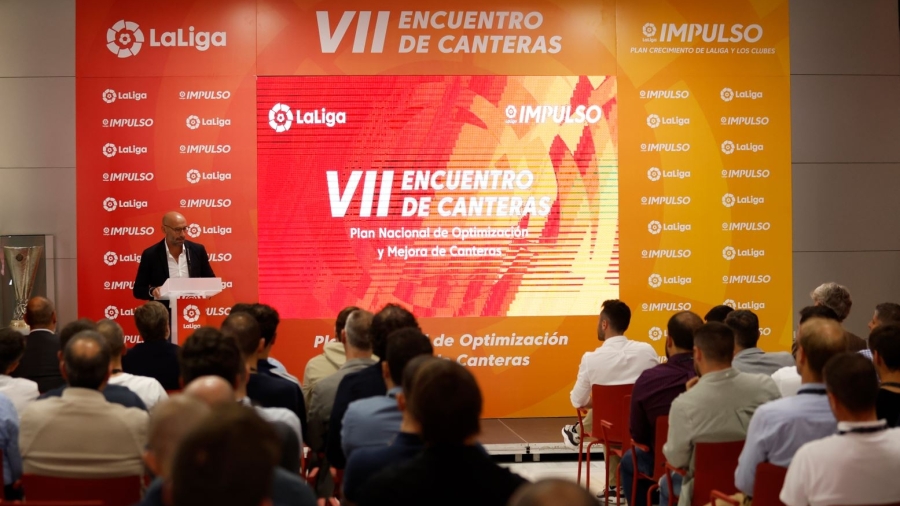
- As part of the transversal ‘LaLiga Impulso’ (Boost LaLiga) project, the National Plan for the Optimisation and Improvement of Youth Academies establishes a series of indicators and objectives for the jump to professional football, academic performance and professionalisation of structures.
- LaLiga clubs' youth academy managers exchanged experiences and knowledge during the seventh ‘Encuentro de Canteras’ meeting at the Ramón Sánchez-Pizjuán stadium, hosted by Sevilla FC.
- It is the first collective plan in Spain to promote professional football youth academies, which are already a worldwide reference, and is the result of the collective effort of the clubs.
LaLiga's National Plan for the Optimisation and Improvement of Youth Academies is celebrating its first year with very good results: the majority of the indicators established for the first phase, which runs until 2025, are already on average between 50-80% of compliance. The collective effort of the clubs, both in the creation and development of the plan, is has led to results exceeding expectations of this 10-year plan that seeks to consolidate LaLiga's leadership in youth academies, establish a sustainable growth model, and close the gap between clubs, increasing competitiveness and democratising the competition.
To discuss results and redirect the objectives of the Plan, linked to the LaLiga Impulso (Boost LaLiga) project, almost a hundred youth academy managers from LaLiga Santander and LaLiga SmartBank clubs met at the seventh ‘Encuentro de Canteras,’ hosted by Sevilla FC in the unbeatable setting of the Ramón Sánchez-Pizjuán stadium.
The Plan is based on five pillars with different indicators and objectives. All of them have grown by an average of 20% in Year One:
- Structure and development of professionals: this area is focused on professionalising the clubs’ structures, with technicians and managers with the best training and working conditions. This first year has seen an increase in the number of full-time professionals, from 32% to 52% of the target, and from 52% to 72% in specific training. In addition, more internal training has been implemented. In terms of structure, the creation and development of the women's youth academy stands out: 85% of the clubs already have women's teams created or in the process of being created in their youth categories.
- Infrastructures and resources: this area focuses on technology and infrastructures, which are essential for the growth of the youth academies. The centralisation and interrelation of data collection and processing tools and other technological processes has increased from 37% to 47%. In addition, 30 of the 42 LaLiga clubs are renovating or building new sports cities within the Infrastructures sections of the Boost LaLiga Plan, which will also have a significant impact on grassroots football.
- Training model and transfer to competition: addresses the training philosophy and plan from a methodological point of view. Most clubs have already established their own methodology and have also made great progress in the individualisation of the processes from 52% to 72%.
- Integral attention to the player: a differential area of the Plan, which points out the need to approach the training of players from a holistic point of view. 72% compliance has already been achieved in the creation of a specific area dedicated to issues such as mental health. In addition, special emphasis has been placed on implementing programmes to increase the percentage of players in High School and University, objectives which have already exceeded 70% compliance, with a general increase in the number of players in higher education. Moreover, a trend of change has been detected in the profile of players who go up to the first team in recent years, who tend to have a higher level of education.
- Development and transfer to professional football: an area that reflects the success of the initiatives and the clubs' commitment to more sustainable growth of their professional teams through the detection and retention of talent in Spain and greater financial rationality in the transfer market. There has been an increase of around 20% compliance in the objectives of academy players in national teams and academy players in the first team, data which already started from high values, as shown in the CIES data below.
"The differential point of this Plan is that it is born from a position of leadership. In the past, these types of plans have been launched in situations of crisis that desperate needed solutions. In our case, we are seeking to further boost an area where we are already strong. The great results of this first season show that clubs are investing in youth development, although we must remember that this is a long-term plan and we will see the most significant results from 2025 onwards. This is just the beginning, we are looking to lay the foundations that will allow us to achieve even more important results and milestones in the medium and long term," says Juan Florit, Head of Sports Projects at LaLiga.
"The youth academies are already a collective brand of LaLiga clubs, as it is not one or two clubs but the clubs as a whole, including LaLiga SmartBank, which consistently leads the world rankings and is making an intensive effort to grow and share best practices. This helps to compensate and reformulate objectives to adapt them to the heterogeneity of clubs, which are at very different stages. It is clear that the collective effort to create a club model compatible with sustainable growth and the current Fair Play regulations is paying off," says Luis Gil, LaLiga's Director of Competitions.
The Youth Academy: LaLiga's collective trademark
The figures make it clear that LaLiga leads both in terms of opportunities and quality of academy players in the Spanish competition itself and in terms of academy players exported to Europe’s five big leagues. This season (2022/23), academy players have played 17.2% of the minutes in the competition, compared to 12.4% in Ligue 1, 11.4% in the Premier League, and much further behind, 7.9% in the Bundesliga or 5.6% in Serie A, making LaLiga the great reference in grassroots football in Europe and the one that gives the most opportunities to its academy players (CIES data up to 2 May 2023).
LaLiga Santander is also the competition with the highest percentage of home-grown players of in Europe’s big five leagues: 21.21% of the total number of players. Homegrown players also account for the highest percentage of the total value among the big leagues: 22.44% of the total market value, followed by the Premier League with 14.54%; Ligue 1 with 13.64%; the Bundesliga with 12% and finally Serie A with 8.7% of the total market value of its players (Transfermarkt data, season 22-23). In other words: LaLiga is the competition that gives the most opportunities to its academy players, and they also have a high market value.
But in addition to training players for their first teams, the high market value of Spanish academy players also translates into profits for the clubs in the transfer market and a Spanish presence in the rest of the leagues. According to CIES data, LaLiga is the competition with the most youth academy products in Europe’s five big leagues this season, with a total of 289 players from 16 different clubs in the Top 100 clubs with the most productive youth academies: Real Madrid, FC Barcelona, Valencia CF, Athletic Club, Real Sociedad, Atlético de Madrid, RCD Espanyol, Villarreal CF, RC Celta, Sevilla FC, CA Osasuna, Rayo Vallecano, RCD Mallorca, Real Betis, Real Valladolid and Málaga CF.
The data certify the differential element of LaLiga: the youth academy as a collective brand.
